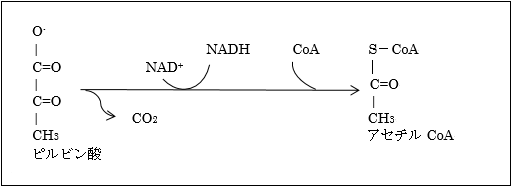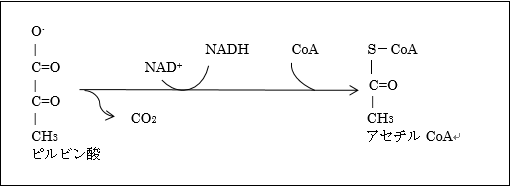|
|||
|
|||
|
|||
解糖、クレープスサイクル 解糖の第1ステージ |
|||
|
グルコースは2分子のリングリセドアルデヒドに分解される。このとき2分子のATP が必要である。 |
|||
|
解糖の第2ステージ |
|||
|
・2分子のリングリセルアルデヒドが2分子のピルビン酸に変換する。 ・2分子のピルビン酸から4分子のATPと2分子のNADHができる。 ・解糖から最終的に2分子のATPができる |
|||
 |
|||
ピルビン酸の酸化とクレプス回路 |
|||
|
・目標:ピルビン酸をクレプス回路に送り込み、NADH と FADH2 を産生する。 ・ミトコンドリア ・ 2段階 |
|||
ピルビン酸の酸化でアセチル CoA となりクレプス回路に入る |
|||
|
・1分子のピルビン酸から2分子の NADH ができる。 ・1分子のピルビン酸から2分子の CO2 が放出される。 |
|||
クレプス回路 |
|||
|
・CoA から6分子の NADH ができる。 ・2分子の FADH ができる。 ・2分子の ATP ができる。 ・4分子の二酸化炭素ができる。 ・8NADH ・2FADH2 ・2ATP ・6CO2 |
|||
How Our Bodies Turn Food into Energy? |
|||
|
All parts of the body (muscles, brain, heart, and liver) need energy too work. This energy comes from the food we eat. Our bodies digest we food w eat by mixing I with fluids (acids and enzymes) in the stomach. When the stomach digest food, the carbohydrate (sugars and starches) in the food breaks down into another type of sugar, called glucose. The small intestines absorb the glucose and then release it into the bloodstream. Once in the bloodstream, glucose can be used immediately for energy or stored in our bodies, to be used later. However, our bodies need insulin in order to use or store glucose for energy. Without inulin, glucose stays in the bloodstream, keeping blood sugar levels high. |
|||
How thee Body Makes Insulin |
|||
|
Insulin is a hormone made by beta cells in the pancreas. Beta cells are very sensitive to the amount of glucose in the bloodstream. Normally beta cells check the blood’s glucose lever every few seconds and sense when they need to speed up or slow down the amount of insulin they’re making an releasing. When someone eats something high in carbohydrates, like a piece of bread, the glucose level in the blood rises and the beta cells trigger the pancreas to release more insulin in the bloodstream. |
|||
Insulin Opens Cell Doors |
|||
|
When insulin is released from the pancreas, it travels through the bloodstream to the body’s cells and tells the cell doors to open up to let the glucose in. Once inside, the cells convert glucose into energy to use right then or store it to use later. As glucose moves from the bloodstream into the cells, blood sugar levels start to drop. The beta cells in the pancreas can tell this is happening, so they slow down the amount of insulin they’re making. At the same lime, the pancreas slows down the amount of insulin that it’s releasing into the bloodstream. When this happens, the amount of glucose going into the cells also slows down |
|||
Glycolysis, Krebs Cycle |
|||
|
The First Stage of Glycolysis |
|||
Glucose (6C) is broken down into 2 PGAL’s (Phosphoglyceraldehyde) This requires two ATP’s |
|||
The second Stage of Glycolysis |
|||
|
・2 PGAL’s (3C) are converted to 2 pyruvates ・This create 4 ATP’s and 2 NADH’s ・The net ATP production of Glycolysis is 2 ATP’s |
|||
Oxidation of Pyruvate and he Krebs Cycle |
|||
|
・Goal+ take pyruvate and put it into the Krebs cycle, producing NADH and FADH2;+ ・Where: the mitochondria ・There are two steps |
|||
| The oxidation of Pyruvate to form Acetyl CoA for Entry into the Krebs Cycle | |||
|
・2 NADH’s are generated (1 per pyruvate) ・2 CO2 are released (1 per pyruvate) |
|||
 |
|||
The Krebs Cycle |
|||
|
・6 NADH’s are generated (3 per Acetyl CoA that enters) ・2 FADH2 is generated (1 per Acetyl CoA that enter) ・2 ATP are generated (1 per Acetyl CoA that enters) ・4 CO2’s are released (2 per CoA that enters) |
|||